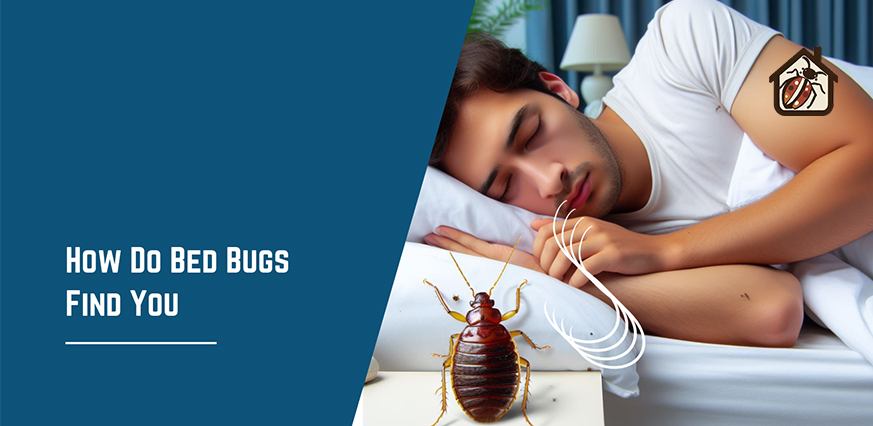
How Do Bed Bugs Find You
Bed bug infestations, a growing concern in recent years, bring discomfort, anxiety, and economic challenges. Understanding how these pests locate their human hosts is essential for effective prevention and control strategies. This article explores the intriguing methods bed bugs employ to detect their food source, including the role of heat, carbon dioxide, and other factors.
By unraveling these detection mechanisms about how do bed bugs find you, we gain insights into their behavior and vulnerabilities, empowering us to proactively protect ourselves and our homes from these unwelcome guests. Join us on a journey of discovery as we unmask the mystery of how do bed bugs find you.
The Science of Bed Bug Attraction
The big question is how do bed bugs find you, the science behind the bed bugs’ attraction towards us is given below:
Breathing Out: You know when we breathe out, right? Well, it turns out that’s a big deal for bed bugs. They’ve got these antennae with super-sensitive sensors that can pick up the carbon dioxide we exhale from up to 15 feet away. That’s like their roadmap leading them straight to a potential blood feast.
Warm Bodies: And get this – they’re like little heat-seeking missiles. We’re warm, and bed bugs love warmth. Thanks to their special sensors, they can detect even the tiniest changes in temperature. So, whether we’re snuggled under blankets or not, they’ve got us pinpointed.
Chemical Signals: But it’s not just our breath and body heat; we emit this mix of chemicals – think pheromones and body odor. Bed bugs find that scent irresistible. It’s like we’re sending out a dinner invitation, and they’re quick to RSVP.
Temperature Preference: Oh, and they’re not fans of cold weather. They prefer it warm, ideally between 70°F to 90°F. Guess what? That’s pretty much the same range as our body temperature. No wonder they find us so inviting!
Blood Sustenance: And here’s the kicker – bed bugs are on a mission for blood. That’s their sole source of sustenance, and we happen to be their top choice. So, it’s like they’re always on the lookout for their next blood buffet, and we’re right at the top of the menu.
What attracts bed bugs
Bed bugs are like scent detectives, using these invisible trails of scent to find their way to us. So. let’s talk about how bed bugs are more than just stealthy heat and CO2 detectors – they’ve got an incredible sense of smell that helps them track us down using a whole range of scents. The things that attract bed bugs are listed below:
| Attractant | Function | Detection Method |
| Carbon Dioxide | Primary attractant | Sensitive antennae sensors |
| Body Heat | Secondary attractant | Thermoreceptors |
| Chemical Signals | Additional attractant | Olfactory receptors |
| Temperature Preference | Habitat preference | Thermoreceptors |
| Thirst for Blood | Survival instinct | Innate biological drive |
Skin and Breath Chemicals
Our skin releases a bunch of different scents known as volatile organic compounds (VOCs). Each one has its unique aroma, and bed bugs are particularly drawn to certain ones, like ammonia and carboxylic acids. These compounds act like markers, telling bed bugs that we’re around. And get this – our breath adds to the mix with chemicals like acetone, making their detection skills even sharper.
Pheromone Communication
Bed bugs are also big on communication, using chemical signals called pheromones. It’s like a secret language among them. These pheromones don’t just help them talk; they can also act as attractants, pulling other bed bugs toward areas where their buddies have already found a good feeding spot. Picture it like a bug meeting point where lots of them hang out in spots with lots of humans.
Olfactory Receptors
Now, here’s where it gets really interesting. Bed bugs have these amazing antennae equipped with specialized olfactory receptors. These receptors are like super-sensitive smell detectors designed to pick up and identify all sorts of scents that we give off. It’s crazy how precise they can be, catching even the tiniest whiffs of chemicals in the air.
Olfactory attractants for bed bugs
| Chemical Source | Type | Function |
| Skin | VOCs (ammonia, carboxylic acids) | Mark human presence |
| Breath | Acetone | Enhance detection |
| Bed Bugs | Pheromones | Attract other bed bugs |
Are bed bugs nocturnal (active at night)?
Bed bugs aren’t your average pests but, they are cunning predators that love the cover of the night. The following states the why:
- Darkness as a Shield: So, picture this: the darkness of the night becomes the perfect hiding place for bed bugs. They’re like little ninjas crawling around undetected, thanks to the cover of darkness. This sneakiness lets them get close to us without us even knowing – no swatting them away or catching them in the act.
- Taking Advantage of Sleep Patterns: Now, here’s where they get clever. Bed bugs are total pros at adapting. They sync up their feeding schedule with our sleep patterns. When we’re peacefully asleep, they come out from their hiding spots, drawn to the warmth and CO2 we naturally give off. It’s like a buffet for them, and we’re none the wiser.
- Quietness: And it’s not just the darkness; it’s the quietness of the night that works in their favor. No extraneous sounds to worry about. Bed bugs can rely on their sense of smell and heat detection to navigate silently, like stealthy little hunters. It’s all about precision and flying under the radar.
Where do bed bugs hide and wait?
Understanding these daytime maneuvers helps us stay ahead of these tricky pests. Keep an eye on bed bugs’ hiding spots, and let’s make sure they don’t turn our beds into feeding grounds!
Hidden Havens
During the day, bed bugs turn into masters of disguise, expertly concealing themselves in spots like cracks, crevices, and furniture frames. They get creative, tucking away behind baseboards, in electrical outlets, and even behind loose wallpaper. Crafty, right?
Close to the Action
While bed bugs love shadows, they strategically position themselves close to where we sleep. This allows them to quickly sense our CO2 and warmth when we start snoozing, emerging for a feeding frenzy. Smart but not something we want in our sleep space!
Patience is Key
Bed bugs are incredibly patient creatures. They can bide their time for several days or weeks between feedings, staying hidden until the perfect opportunity arises. This knack for conserving energy and remaining undetected is what allows them to thrive in ever-changing environments.
Bed bugs’s preferred hiding spaces
The main issue is figuring out where bed bugs are hiding. You can understand where bed bugs might hide. How do I find bed bugs?
| Location | Description |
| Mattress seams, folds, and tufts | Provide ample hiding space and close access to hosts. |
| Box spring crevices and inner structure | Offer a dark, protected environment for bed bugs to dwell. |
| Headboard cracks and surrounding furniture | Allow for proximity to sleeping humans and easy access to feeding sites. |
| Baseboards and behind electrical outlets | Provide secluded areas near beds and furniture. |
| Loose wallpaper and wall voids | Offer dark, hidden spaces for bed bugs to reside. |
How do we encounter bed bugs?
Here’s the deal – being mindful of these scenarios can help us navigate the risks and keep our living spaces free from these unwelcome bed bug encounters. Let’s stay aware and create a bug-free zone.
Travel Woes
Alright, let’s talk about how our adventures might inadvertently lead us to bed bugs. When we travel, whether it’s hotels, airports, or public transportation, we’re stepping into environments where bed bugs love to hang out. The catch? Bringing back luggage or clothing that’s been exposed can unknowingly introduce these pests into our homes. It’s like an unexpected souvenir we’d rather not have.
Shared Spaces
Ever thought about the shared places we frequent? Libraries, laundromats, and second-hand furniture stores – these spots can be hotbeds for bed bugs. Infestations lurk, and coming into contact with infested items can bring these unwanted guests right into our living spaces. It’s a tricky dance we might not even know we’re a part of.
Clutter and Concealment
Now, here’s an eye-opener – clutter isn’t just a visual challenge; it’s a bed bug haven. Bedrooms piled with clothes, boxes, or furniture provide perfect hiding spots for these little critters. They thrive undetected, turning our cluttered spaces into their ideal homes.
Unintentional Introductions
In our everyday actions, we might unknowingly welcome bed bugs. Borrowing or buying used furniture, sharing clothing, or receiving packages from infested environments – seemingly innocent gestures that can pose potential risks. It’s like they find a way in without us even realizing it.
You may also like:
FAQs
1. How do bed bugs sense their prey?
2. How close do bed bugs need to be to detect you?
3. Do bed bugs have other ways of finding you?
4. Can bed bugs travel long distances to find you?
5. Can bed bugs find you through walls?
6. Are some people more susceptible to bed bug bites than others?
7. How to minimize the risk of attracting bed bugs?
Conclusion
Bed bugs are expert hunters, relying on their heightened senses like CO2 detection and heat sensitivity, combined with our unwitting behaviors such as travel and clutter, creating an ideal scenario for infestations. Recognizing how bed bugs find you is crucial. To stay ahead, keep spaces clutter-free, be cautious during travel, and stay mindful in shared areas. This proactive approach significantly reduces the risk of bed bug encounters, allowing for peaceful nights without worry.


